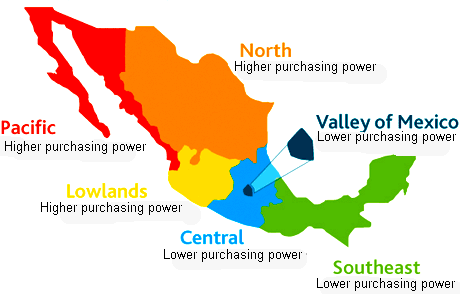Nielsen, the world’s leading consumer information and research company (offices in more than 100 countries), recently analyzed the shopping habits of consumers in Mexico. From a geographical perspective, one of the most valuable aspects of the study is Nielsen’s use of consumer purchasing habits to suggest a division of Mexico into distinct shopping regions.
The market for consumer goods in Mexico is very large, and has grown rapidly since the 1980s. Mexico is now the world’s 11th most populous nation (112.3 million people in 2010) and has the world’s 11th largest economy. It is also the most populous Spanish-speaking country in the world. Mexico’s size and diversity result in great variations in consumer patterns from one area to another. To achieve maximum success, manufacturers, distributors and retailers in Mexico need to appreciate these regional differences.
As we have stressed in previous posts, Mexico has a marked north-south divide. Inhabitants in the north tend to be better-educated and live in smaller households, with higher household incomes and more purchasing power than their counterparts in southern Mexico. The Nielsen study broadly supports this division of wealth, but adds some refinements to the pattern.
The map summarizes Nielsen’s view of the pattern of Mexico’s consumer habits. Throughout the country, small traditional stores (defined by Nielsen as those stores where a salesperson or clerk must be present to serve shoppers) remain a vitally important option for consumer purchases.
Convenience stores and small supermarkets are most popular in Nielsen’s Pacific and North areas. Larger supermarkets are more important in the Valley of Mexico and in the Southeast region.
In all regions, traditional convenience stores are visited frequently, either daily or even twice-daily. Consumers typically visit the nearest supermarket twice a week, with Sunday being the single most popular shopping day. Mid-week supermarket shopping is most common in the Pacific, North and Southeast areas.
Related post:

Sorry, the comment form is closed at this time.